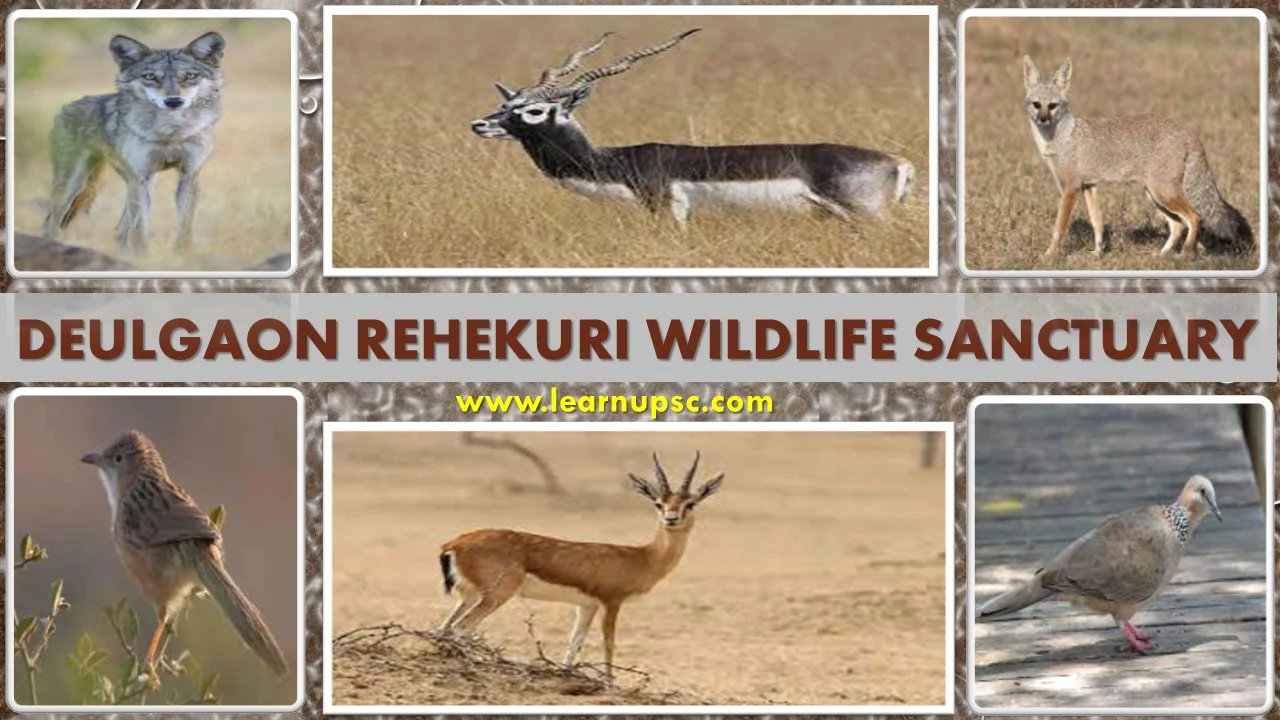Deulgaon Rehekuri Wildlife Sanctuary UPSC
Deulgaon Rehekuri Wildlife Sanctuary is a protected area located in the state of Maharashtra, India. It was established to conserve the natural biodiversity and provide a safe haven for various wildlife species.
The sanctuary was established to conserve the endangered Blackbuck, locally known as "Kalvit". The creation of this sanctuary has accorded much needed protection to the blackbucks of the region. This has resulted in the population increasing very significantly over the years.
The landscape of the sanctuary comprises dry deciduous forests, grasslands, and rocky outcrops, making it a diverse habitat for different species. The sanctuary is also known for its archaeological significance, as it contains ancient rock-cut caves and inscriptions that date back to the Mauryan period.
|
Table of Contents
|
Deulgaon Rehekuri Wildlife Sanctuary Location
The Deulgaon Rehekuri Wildlife Sanctuary is located in the Ahmednagar district of Maharashtra, India. It is situated in the northern part of the Western Ghats, which is a UNESCO World Heritage Site known for its rich biodiversity.
Deulgaon Rehekuri Wildlife Sanctuary Nearest Airport:
The nearest airport to the Deulgaon Rehekuri Wildlife Sanctuary is the Aurangabad Airport (Chhatrapati Sambhaji Raje Airport). It is located in Aurangabad, Maharashtra, and is approximately 160 to 170 kilometers away from the sanctuary, depending on the route taken.
Deulgaon Rehekuri Wildlife Sanctuary Nearest Railway Station:
As for the nearest railway station, the Ahmednagar Railway Station is the closest one to the Deulgaon Rehekuri Wildlife Sanctuary. It's situated in Ahmednagar, Maharashtra. The distance from the railway station to the sanctuary is around 60 to 70 kilometers, depending on the specific route chosen.
Deulgaon Rehekuri Wildlife Sanctuary History
The Deulgaon Rehekuri Wildlife Sanctuary boasts a captivating history that intertwines natural conservation, archaeological significance, and community engagement.
Establishment: The sanctuary was officially notified on the 29th of February, 1980, marking a crucial milestone in its establishment and the commitment to preserving its ecological and cultural heritage.
Archaeological Significance: Beyond its ecological importance, the sanctuary houses ancient rock-cut caves and inscriptions that trace their origins back to the Mauryan period, dating around 300 BCE. These historical artifacts provide valuable insights into the cultural and historical heritage of the region, offering a glimpse into its distant past.
Deulgaon Rehekuri Wildlife Sanctuary Area
The Deulgaon Rehekuri Wildlife Sanctuary covers an approximate area of 2.17 square kilometers. The relatively compact size of the sanctuary allows for concentrated conservation efforts and focused management to preserve the unique biodiversity found within its boundaries.
Deulgaon Rehekuri Wildlife Sanctuary Flora
The Deulgaon Rehekuri Wildlife Sanctuary boasts a diverse array of flora, primarily consisting of dry deciduous scrub forest vegetation. This unique ecosystem is home to various plant species that have adapted to the region's climate and environmental conditions.
Some of the notable flora found within the sanctuary includes:
Chandan (Santalum album): Also known as Indian sandalwood, chandan is a fragrant tree known for its valuable heartwood, which is used to produce sandalwood oil and various aromatic products.
Khair (Acacia catechu): Khair, also known as catechu or cutch tree, is valued for its tannin-rich heartwood, which is used in tanning and dyeing processes. It's a common tree in the region's dry deciduous forests.
Hivar (Acacia nilotica): Hivar, also known as babul or Indian gum arabic tree, is a thorny tree that provides valuable resources such as fodder, gum, and wood.
Sisoo (Dalbergia sissoo): Also known as Indian rosewood, sisoo is a fast-growing tree with strong and durable wood. It's used for furniture making and other woodworking purposes.
Ber (Ziziphus mauritiana): Ber, or Indian jujube, produces small edible fruits and is culturally significant in many parts of India.
Karwand (Carissa congesta): Karwand, or conkerberry, is a shrub known for its small, round, edible berries.
Alysicarpus bupleurifolius: A species of leguminous plant.
Cyathocline purpurea: A flowering plant with purple flowers.
Eriocaulon diane: A type of herbaceous plant often found in wet or marshy areas.
Merremia emarginata: A species of morning glory known for its attractive flowers.
Cucumis melo: A type of melon plant.
Cyperus kyllingia: A species of sedge, often found in wetlands.
Striga densiflora: A flowering plant commonly known as witchweed.
Mareilea minuta: A type of aquatic plant often found in freshwater habitats.
Deulgaon Rehekuri Wildlife Sanctuary Fauna (Deulgaon Rehekuri Wildlife Sanctuary Animals)
The Deulgaon Rehekuri Wildlife Sanctuary is home to a variety of fauna, including mammals, birds, reptiles, and more. Here are some of the notable wildlife species that can be found within the sanctuary:
Mammals:
- Blackbuck
- Chinkara
- Wolf
- Indian Fox
Birds:
- Common Babbler
- Jungle Babbler
- Small Bee-eater
- Red-vented Bulbul
- Spotted Dove
- Cattle Egret
- Little Egret
- Black Drongo
- Woodpecker
Reptiles:
- Indian Python
- Common Indian Monitor
- Indian Star Tortoise
- Indian Cobra
- Russell’s Viper
Deulgaon Rehekuri Wildlife Sanctuary UPSC Questions
Q. Where is Deulgaon Rehekuri Wildlife Sanctuary?
A. The Deulgaon Rehekuri Wildlife Sanctuary is located in the Ahmednagar district of Maharashtra, India. It is situated in the northern part of the Western Ghats, a UNESCO World Heritage Site known for its rich biodiversity.


No comments:
Post a Comment